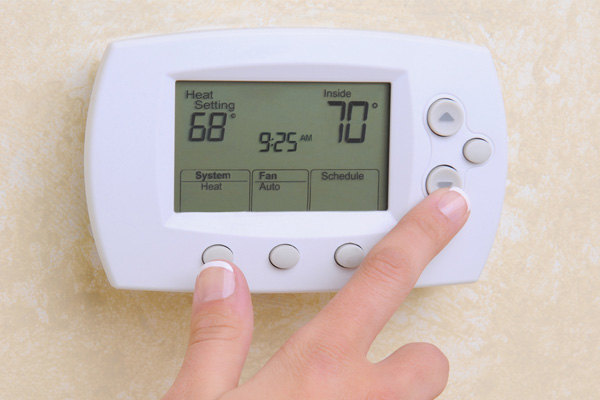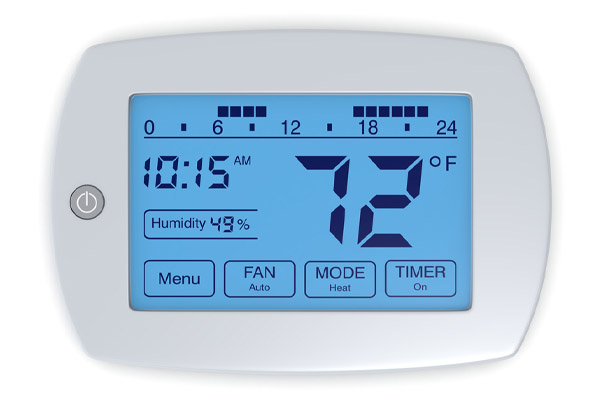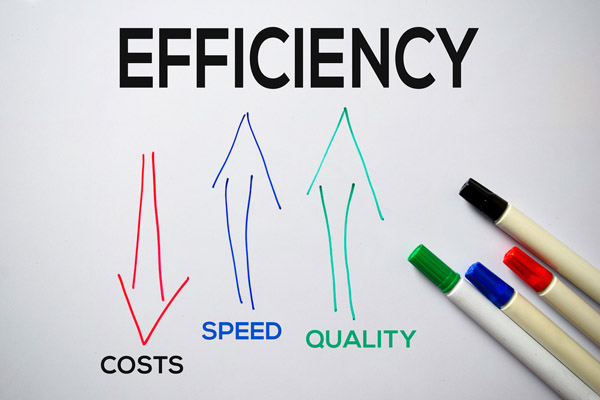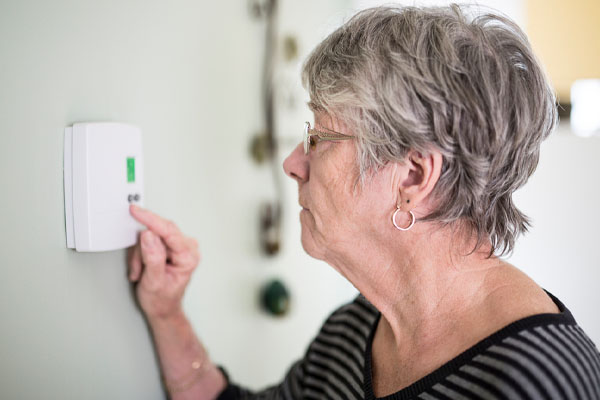Thermostat Setback: Can Dialing Down Your Thermostat Ease Your Budget?

The HVAC thermostat is at the heart of energy-efficient heating and cooling solutions. These compact devices have the remarkable ability to refine indoor comfort, all while making a notable difference in energy usage. The concept of a thermostat setback emerges as an intuitive yet powerful method to enhance energy optimization. With a set back thermostat, one can easily make temperature shifts during hours when rooms are vacant or during nighttime rest.
Join us as we unpack the monetary and environmental rewards of integrating a thermostat setback, emphasizing its significance for your budget and our Earth.
Grasping the Concept of Thermostat Setback
Contents

A set back thermostat, sometimes termed temperature setback, involves purposely adjusting the temperature—either decreasing it for heating or increasing it for cooling—on your thermostat at certain times to save energy. It’s commonly applied when the premises are empty or residents are asleep.
Thermostat setback can be implemented using different thermostats, such as:
- Manual Thermostats: These demand that users change the temperature settings by hand.
- Programmable Thermostats: These provide users the flexibility to preset temperature alterations beforehand.
- Smart Thermostats: These innovative devices can adapt to your routine and offer the convenience of modifying settings through mobile applications.
Thermostat setback works by reducing the load on your heating or cooling system when it’s not fully needed. For example, during winter, you can set it to lower the temperature while you’re at work and increase it before you return home, preventing the system from running at full capacity in an empty house.
This strategy not only cuts down on energy usage and utility bills but also reduces your carbon footprint. By ensuring comfort when necessary and conserving energy when possible, thermostat setback offers significant financial savings and contributes to a more environmentally friendly lifestyle.
Energy Usage and Financial Benefits

Adjusting your thermostat’s temperature can significantly affect your HVAC system’s energy consumption, with higher settings in winter and lower in summer leading to increased usage. Homeowners can potentially reduce their HVAC expenses by up to 10% by setting their thermostat 7 to 10 degrees Fahrenheit lower (or higher) for 8 hours a day.
Regularly lowering the temperature when leaving for work or going to bed can notably cut heating costs, leading to lower utility bills and financial savings. Additionally, this practice of thermostat setback has environmental benefits, such as reduced carbon emissions from lower energy production, contributing to a smaller carbon footprint, and a more sustainable future.
Making the Ideal Thermostat Choice
When choosing a thermostat for your home, you have several options. Manual thermostats offer basic temperature control, while programmable ones allow for scheduled temperature changes and energy-efficient settings. Smart thermostats go a step further, adapting to your habits and offering remote adjustments via mobile apps.
Your choice should be influenced by your daily routine, commitments, heating or cooling needs, and how much flexibility you want in setting temperatures. Consider factors like cost, ease of use, and compatibility with your HVAC system. Thermostat installation varies, with some being easy DIY projects and others requiring professional setup. For smart thermostats, Wi-Fi connectivity and a compatible app are essential. Make sure your home is prepared for these requirements.
Adjusting and Configuring Thermostats

Finding the right balance between energy savings and comfort is crucial when setting thermostat temperatures. For heating, set the temperature slightly lower than your usual comfort level; for cooling, a bit higher. Avoid large temperature swings, as they can lead to inefficient, prolonged periods of returning to the desired temperature.
When using a set back thermostat, coordinate your temperature adjustments with your daily routine, like lowering the heat or raising the cooling while at work or asleep. Most programmable and smart thermostats allow for multiple time settings, enabling precise scheduling.
For best results, keep your setback routines consistent and make gradual rather than sudden temperature changes, which is easier on your HVAC system. Regular maintenance also ensures system efficiency. Contrary to some beliefs, research shows that adjusting temperatures when away or asleep is more energy-efficient than maintaining a constant temperature, leading to both energy and cost savings.
Monitoring and Adjustment
It’s wise to occasionally review your energy statements to assess the effectiveness of your set back thermostat configurations. Observe any patterns and tweak settings as required. For those with smart thermostats, these devices often furnish comprehensive consumption insights.
Don’t forget to modify your setback preferences with the shifting seasons. During chillier periods, you might opt for a reduced heating setback. Conversely, as the weather warms, elevate the cooling setback temperature.
Smart thermostats typically boast remote access and monitoring capabilities. This lets you tweak settings via your smartphone and gain a better understanding of your energy consumption patterns. Such features streamline the fine-tuning of your setback approach.
If you face challenges with your thermostat or its setback configurations, refer to the user guide or contact the manufacturer for support. Frequently encountered problems encompass:
- Errors in programming
- Wi-Fi connection issues
Tips for Energy-Efficient HVAC Operation

Routine upkeep is vital for the optimal functioning of your HVAC system. For consistent and efficient performance, adhere to these guidelines:
- Replace air filters consistently.
- Clear out ducts and vents.
- Arrange for yearly check-ups.
To maintain a stable indoor climate, seal any gaps around windows, doors, and other entry points, and ensure good insulation in attics, walls, and floors. Using energy-efficient windows and doors can reduce heat exchange and ease your HVAC system’s workload. Promote air circulation in your home with ceiling fans and consider a heat recovery ventilation system for efficient air exchange.
When upgrading, choose heating and cooling systems with high SEER (Seasonal Energy Efficiency Ratio) ratings for air conditioners and heat pumps, and high AFUE (Annual Fuel Utilization Efficiency) ratings for furnaces, leading to long-term energy conservation.
Potential Hurdles and Their Resolutions
If a set back thermostat leads to discomfort, adjust the temperatures slightly or explore zoning solutions. Adding air purifiers and humidifiers can improve indoor air quality. In extreme weather, consider lessening the temperature changes or using a smart thermostat that adapts to weather changes while maintaining efficiency.
For any technical issues with your thermostat settings, consult a professional technician for accurate troubleshooting and repair. Strive for a balance between comfort and energy savings by gradually tweaking setback temperatures and maintaining your HVAC system. Utilize additional devices and insulation techniques to create a comfortable indoor environment.
In Summary
The practice of a set back thermostat presents many benefits, such as notable financial savings, diminished ecological effects, and heightened energy proficiency. By judicious management of indoor temperatures, you can revel in home comfort and promote a greener tomorrow. Consider tapping into expert HVAC services for thermostat fine-tuning for optimal results from this energy conservation tactic. Act today and receive enduring economic and eco-friendly rewards while relishing your home’s warmth and comfort.
Reach Out to Point Bay Fuel For All Your HVAC Needs
Point Bay Fuel is the leading heating and cooling solutions provider in Ocean County and Monmouth County, New Jersey. Our team comprises top-tier certified professionals committed to delivering outstanding HVAC services, from routine tune-ups to comprehensive installations and replacements. With our technicians’ extensive expertise, you can be confident in our ability to address all your HVAC needs proficiently.
At Point Bay Fuel, we pride ourselves on offering the most affordable rates for heating and cooling services in the vicinity. Our maintenance solutions amplify your comfort and enhance energy efficiency, trimming down your household’s heating and cooling expenses. Should you need HVAC repairs or a system replacement, rest assured we’ll guide you to the ideal solution tailored to your residence and budget. We stand firmly behind our work, guaranteeing your utmost satisfaction. Ready to book a service? Call Point Bay Fuel now. We’re pleased to offer complimentary in-home assessments.
Contact us now by calling (732) 349-5059 to speak to one of our home comfort specialists! Click the link to view our service area.

Related Articles:
